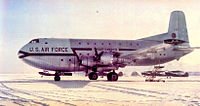
Photo from wikipedia
Abstract Aviation safety knowledge is a key factor in determining how passengers will respond in an emergency, but the effectiveness of the tools (preflight safety briefing, safety briefing card) used… Click to show full abstract
Abstract Aviation safety knowledge is a key factor in determining how passengers will respond in an emergency, but the effectiveness of the tools (preflight safety briefing, safety briefing card) used by airlines to educate passengers about safety has been shown to be lacking. This paper explores how one of these tools could be made interactive in order to increase its effectiveness. In particular, we use Virtual Reality (VR) techniques, adapting them to the constraints imposed by on-board aircraft use, such as usage on non-immersive, small displays. As a practical application, the paper examines aviation life preserver donning, which the literature has shown to be particularly difficult for passengers. To evaluate the proposed mobile VR tool, we contrasted it with the traditional safety briefing card in a between-groups study with 68 participants, age 20–24, focusing on different aspects of effectiveness. The results of the study show that the participants who used the mobile VR tool were able to transfer the presented safety knowledge to the real world, and don an aviation life preserver significantly faster and with fewer errors than participants who used the traditional briefing card. Moreover, these objective results were consistent with subjective ratings by participants; the mobile VR tool was perceived as significantly more engaging, simpler, and more effective than the traditional briefing card. Finally, participants who used the mobile VR tool attained a higher level of self-efficacy. The generalizability of these results would benefit with additional work aimed at an older age cohort that would ostensibly be less familiar with interactive VR technology.
Journal Title: Safety Science
Year Published: 2018
Link to full text (if available)
Share on Social Media: Sign Up to like & get
recommendations!